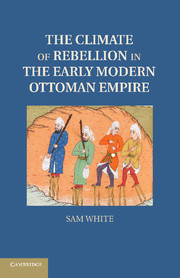Book contents
- Frontmatter
- Contents
- Acknowledgments
- Preface
- Glossary of Ottoman Terms
- Maps
- Introduction
- Part I An Imperial Ecology
- 1 Regions, Resources, and Settlement
- 2 Growth and Its Limits
- 3 Disasters of the Late Sixteenth Century
- 4 Land at The Margins
- Part II The Little Ice Age Crisis
- Part III Ecological Transformation
- Conclusion
- Bibliography
- Index
- References
3 - Disasters of the Late Sixteenth Century
Published online by Cambridge University Press: 05 February 2012
- Frontmatter
- Contents
- Acknowledgments
- Preface
- Glossary of Ottoman Terms
- Maps
- Introduction
- Part I An Imperial Ecology
- 1 Regions, Resources, and Settlement
- 2 Growth and Its Limits
- 3 Disasters of the Late Sixteenth Century
- 4 Land at The Margins
- Part II The Little Ice Age Crisis
- Part III Ecological Transformation
- Conclusion
- Bibliography
- Index
- References
Summary
It was not population pressure alone, but population pressure combined with natural disaster and imperial missteps that drove the empire into rebellion and crisis. To understand how the catastrophe unfolded, we need first to examine the empire's vulnerabilities and responses to natural disaster more closely. In the generation leading up to the crisis of the 1590s, the Ottomans weathered a number of violent storms, both literal and metaphorical. These events tested the strength of imperial authority and its systems of population and resource management against the vagaries of man and nature. The threats came from the usual suspects: famine, pestilence and death, and war – the classic Four Horsemen of the Apocalypse. The underlying causes of disaster, however, were frequently meteorological, above all the severe winters and spring droughts that characterized the onset of the Little Ice Age.
- Type
- Chapter
- Information
- The Climate of Rebellion in the Early Modern Ottoman Empire , pp. 78 - 103Publisher: Cambridge University PressPrint publication year: 2011

